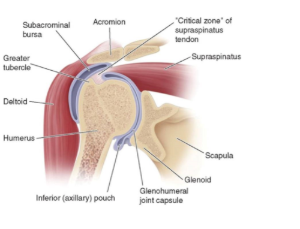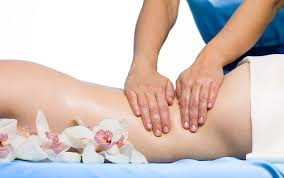
What is bursitis?
Subacromial (shoulder) bursitis is a condition
caused by inflammation of the bursa that separates the
superior surface of the supraspinatus tendon (one
of the four tendons of the rotator cuff) from the
overlying coraco-acromial ligament, acromion,
coracoid (the acromial arch) and from the deep surface of the deltoid muscle. The subacromial bursa helps the
motion of the supraspinatus tendon of the rotator cuff in activities such as
overhead work.
Musculoskeletal complaints are one of the most common reasons for primary care office visits, and rotator cuff disorders are the most common source of shoulder pain.
Primary inflammation of the subacromial bursa is
relatively rare and may arise from autoimmune inflammatory conditions such as rheumatoid arthritis; crystal deposition disorders such as gout calcific loose bodies, and infection.
More commonly, subacromial bursitis arises as a
result of complex factors, thought to cause shoulder impingement symptoms. They are further divided into primary or secondary
causes of impingement. Secondary causes are thought to be part of another
process such as shoulder instability or nerve injury
How does bursitis affect you?
Which motion is most limited and
painful in cases of acute bursitis of the shoulder?
Passive abduction. In cases of acute bursitis (swelling of the bursa), passively abducting the arm – performed by the therapist – is very painful because the head of the humerus is compressing a swollen bursa against the glenohumeral joint and the underside of the acromion.
The bursa is generally the size of a small plum, but when inflamed it can be as big as an orange. When acute bursitis is present in the shoulder, it is impossible to lift the arm out to the side (abduction) without extreme pain.
Massage for bursitis treatment?
Is massage therapy a useful treatment
in cases of bursitis of the shoulder?
No. Inflammation of a bursa is not helped by direct massage. Directly massaging an inflamed bursa will cause more pain.
Massage for rotator cuff impingement
However, in the case of impingement of the rotator cuff muscles, massage can help with the reduction of tension of these muscles which can result in less pressure on the bursa
Bursitis Symptoms
Symptoms of Bursitis include…
- Pain on the outside of your shoulder.
- Pain may spread down your arm towards the elbow or wrist.
- Pain made worse when lying on your affected shoulder.
- Pain made worse when using your arm above your head.
- Painful arc of movement – shoulder pain felt between 60 – 90° of arm
moving up and outwards.
Treatment for bursitis
Treatment will depend on the cause of bursitis and aims to alleviate the symptoms as much as possible while the healing process takes place.
Options may include pain-relieving medications, cold packs, gentle mobilising exercises and rest. Anti-inflammatory medications or injections of corticosteroids may be used in cases of severe pain.
If an infection is present, warmth, redness, pain and swelling will be experienced in the affected areas. Treatment with an appropriate antibiotic is necessary.
If the bursitis was triggered by a particular form of overuse, it is important
to avoid that activity. Such as a sport.

 Most of us go into the ‘I’m going to get healthy for Summer’ or ‘I plan to drop some Kilo’s before Summer’ frame of mind in the months leading up to December.
Most of us go into the ‘I’m going to get healthy for Summer’ or ‘I plan to drop some Kilo’s before Summer’ frame of mind in the months leading up to December.
